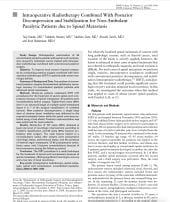OVERVIEW
Retrospective examination of 96 nonambulant paralytic patients with spinal cord compression caused by metastatic cancer treated with intraoperative radiotherapy combined with conventional posterior surgery.
Few studies of conventional posterior surgery demonstrated satisfactory neurologic recovery for nonambulant paralytic patients with advanced spinal metastases.
METHODS AND MATERIALS
Ninety-six patients underwent IORT (107 procedures) for the treatment of severe spinal cord compression because of spinal metastases. All patients were nonambulatory before surgery. Eighty-three cases (86%) were in an advanced stage of multiple spinal metastases (types 6 or 7 of the surgical classification of vertebral tumors). After posterior decompression, a single large dose of electron beam irradiation was delivered to the exposed metastatic lesion while the spinal cord was protected using a lead shield. Posterior instrumentation was also performed for most patients.
RESULTS
Ninety-five of 107 cases (89%) obtained at least one level of neurologic improvement according to Frankel’s classification and 86 cases (80%) became ambulatory after surgery. The main factors related to a nonambulatory status after surgery were preoperative neurologic status, performance status, and the presence of internal organ metastases. Of 86 postoperative ambulatory cases, only 3 became nonambulatory because of local recurrence during the follow-up period.
CONCLUSION
The IORT procedure is a useful technique for the treatment of spinal cord compression because of spinal metastasis, offering significant neurologic recovery and a low rate of local recurrence.
